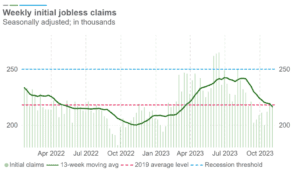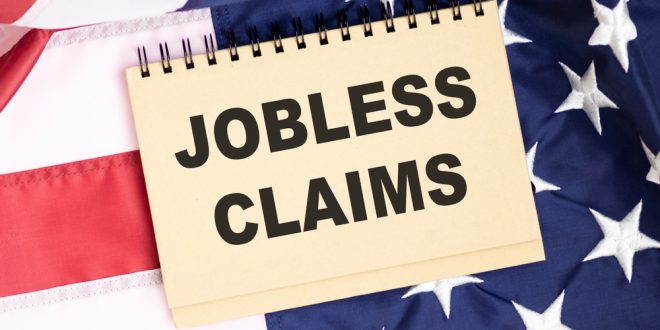Jobless claims in the US have fallen to their minimum level since February in the week ending September 2, 2023, according to the US Department of Labor. The US economy is benefiting from the decrease in unemployment claims. It indicates that firms are hiring and that more people are employed. It also implies that to thwart inflation, the Federal Reserve will probably keep hiking interest rates.
The US labor market is booming. The economy is adding jobs quickly, and unemployment claims are near historic lows. This benefits both job seekers and employers.
The US labor market remains strong, with jobless claims declining to near-historic lows. This is the latest sign that the economy is continuing to recover from the COVID-19 pandemic. According to the Labor Department, the number of Americans filing new claims for unemployment benefits fell by 2,000 to 190,000 last week. This is the lowest level of jobless claims since 1969.
What are the Initial Claims?
According to the Bureau of Labor Statistics data, the workforce comprises those presently engaged in employment and those actively searching for work but currently without employment. Individuals who are actively involved in remunerative activities are classified as being employed.
Individuals currently without employment, actively seeking employment opportunities, and able to engage in work are classified as unemployed. The user’s text is not sufficient to be rewritten academically.
As previously stated, the metric of new jobless claims indicates the onset of unemployment. In contrast, the data on ongoing claims quantifies the number of individuals still receiving unemployment benefits. The release of persistent claims data occurs with a one-week delay compared to the release of original claims data. Due to this rationale, the preliminary assertions typically exert a more significant influence on the financial markets.
Is It a Good sign of Reducing Jobless Claims?
The continuing claims rate, which measures the number of people receiving unemployment benefits for more than one week, also fell last week. The continuing claims rate dropped by 5,000 to 1.655 million.
The decline in jobless claims indicates employers continue hiring and that workers are finding jobs. This is good news for the economy as a whole, as it means more people are employed and earning money.
The strong labor market is also helping to keep inflation in check. Employers have to compete for workers by offering higher wages when there are more jobs than workers. This can help to push up wages across the economy, which can help to boost consumer spending and economic growth.
The decline in jobless claims is a positive sign for the US economy. It suggests that the labor market is strong and the economy is recovering from the COVID-19 pandemic.
Revolution of Jobless Claims Fallen in USA
The number of job vacancies in June 2021 declined to less than 9.6 million, marking the lowest level observed in over two years. Nevertheless, it is noteworthy that the figures exhibit exceptional resilience, given that the monthly job vacancies had never surpassed the 8 million mark before 2021.
In addition to a notable wave of workforce reductions observed in the technology industry during the initial months of the current year, organizations have predominantly focused on preserving their employees.
Many enterprises encountered challenges reestablishing their labor forces after downsizing operations during the pandemic. The current recruitment opportunities these corporations undertake are primarily driven by their pursuit to align with the heightened levels of consumer demand that have materialized in the aftermath of the pandemic-induced economic downturn.
Factors Caused Jobless Claims
There are several reasons US jobless claims have dropped. The economy is expanding. Jobs outnumber workers, and unemployment is low. Employers compete for workers by offering higher salaries and benefits. This makes finding work more accessible and reduces unemployment.
Second, the government is aiding job seekers. To help job seekers, the government provides job training and financial aid. This helps people obtain job and self-sufficiency skills.
Third, the economy is recovering from COVID-19. The pandemic cost many jobs, but the economy is recovering. The economy is improving, generating more jobs and employing more people.
Jobless claims are down, which is good for the US economy. It shows the economy is recovering from the COVID-19 pandemic, the government is helping people find work, and the economy is increasing.
Additional factors why US jobless claims may have dropped:
Robust Consumer Spending and Business Investment: Economic growth and job creation are driven by solid consumer spending and business investment in new equipment and facilities.
Favorable tax policies: Government tax cuts encourage business investment and hiring.
Deregulation: Reduced restrictions lower business costs and facilitate growth.
Jobless claims vary from week to week. Therefore, looking at the data over a more extended period is best to gain a more realistic view of the labor market. Positive jobless claims trends indicate a solid US labor market.
In Which Ares Job Hiring Started?
Although there has been a deceleration in recruiting within the manufacturing, warehousing, and retail sectors in recent months, significant job cuts have not been observed thus far. According to economists, in light of the challenges encountered in recruiting employees over the previous couple of years, firms are expected to retain their workforce for extended durations, even during a potential economic downturn.
In total, 1.72 million individuals were in receipt of unemployment benefits during the week concluding on August 5, representing an increase of approximately 32,000 individuals compared to the preceding week.
What will be the Impacts of Jobless Robustness on Financial Stability?
The robustness of the United States economy significantly influences the fluctuations of the United States dollar (USD) in relation to other prominent currencies. This phenomenon can be attributed, in part, to the positive correlation between a robust economy and elevated interest rates, which consequently enhances the relative appeal of a currency.
Currency traders are prone to perceive an early claim reading that surpasses expectations as unfavorable or indicative of a bearish sentiment toward the USD. Conversely, a lower-than-anticipated figure would be regarded as excellent or reflective of a bullish outlook. For instance, a trader who observed an early claims total of 187,000, as opposed to the previous week’s 215,000 and the projected 210,000, may exhibit a greater inclination to purchase the USD in relation to other currencies.
In the context of bonds, it is commonly perceived that a reading exceeding expectations indicates a positive sentiment, whilst a reading falling short is regarded as unfavorable. First-time unemployment claims that are unexpectedly high are likely to indicate economic fragility, typically linked to declining interest rates and an increased stock market.
Unemployment claims are also utilized as input variables in models and indicators. As an illustration, including average weekly initial unemployment claims is among the ten constituent factors considered in constructing the Composite Index of Leading Indicators by the Conference Board.
What are Seasonal Adjusted Jobless Claims?
Instead of emphasizing the numerical quantity of claims, which exhibited higher levels during previous economic cycles before the recent improvement in labor market conditions, we analyze the rate and duration of the rise. To accomplish this, novel, sophisticated metrics are devised for initial and ongoing claims.

The observed rise in unemployment rates implies that individuals who continue to receive unemployment benefits face more significant challenges in securing new employment opportunities, in contrast to the corresponding period in the previous year.
Furthermore, it is anticipated that there will be increased opportunities for the emergence of novel assertions, given the projected substantial deceleration of the economy in the concluding quarter. Temporary workers employed during the third quarter to cater to specific and time-limited occasions may face termination when demand diminishes.
Future Outcomes of Labor Market
After a third quarter with 4.9% annualized GDP growth, more robust than forecast, growth is expected to decrease. A Treasury report this week predicted 0.7% fourth-quarter GDP growth and 1% for 2025. Fed policymakers have slowed the economy to fight inflation. The Fed’s rate-setting committee held the line for the second straight meeting on Wednesday after 11 rises since March 2022.
While markets expect the Fed to stop hiking rates, officials say they rely on incoming data and could raise more if inflation doesn’t decline. Recent inflation data is mixed. The Fed’s preferred indicator showed the annual rate decreased to 3.7% in September, indicating modest but steady progress towards its goal. Robust consumer spending has allowed enterprises to raise prices due to robust demand. However, economists worry that mounting credit card bills and savings withdrawals could reduce consumption.
Conclusion
The Labor Department announced 9.6 million September 2023 job opportunities, up from 9.5 million in August. Layoffs dropped from 1.7 million to 1.5 million. In October 2023, private companies added 150,000 positions, a modest but healthy increase. Job growth fell substantially from September’s 297,000 gain, but it was still strong enough to indicate that many employers want to hire and that the economy is strong.
